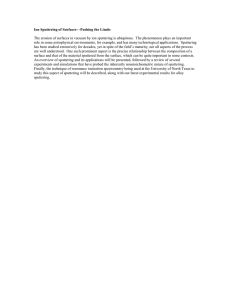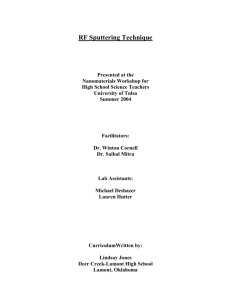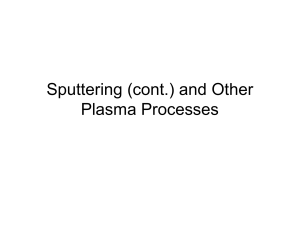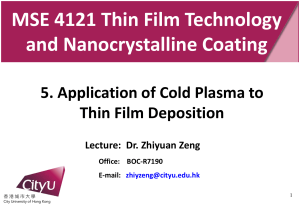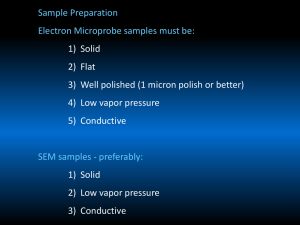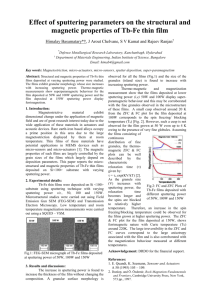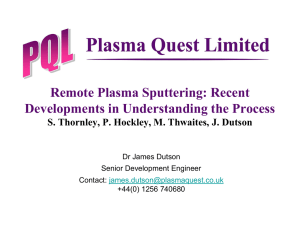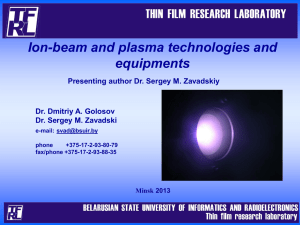Sputtering
advertisement
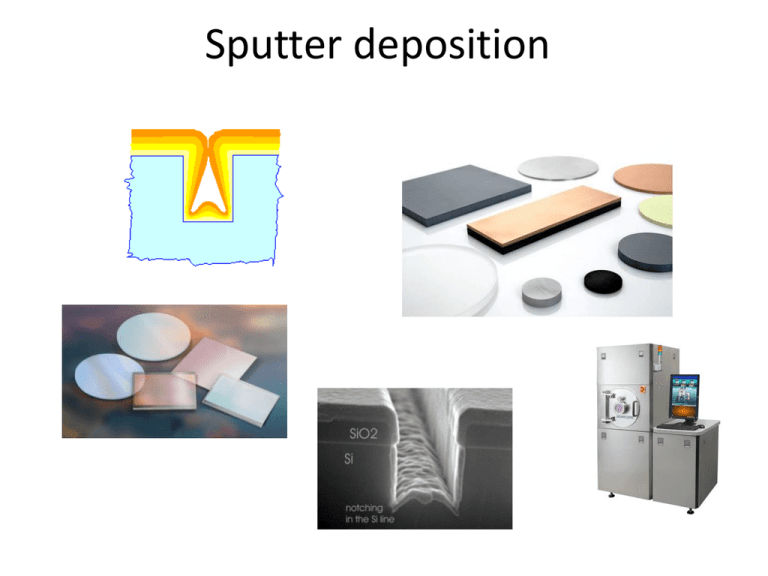
Sputter deposition Sputtering An accelerated ion incident on a material can transfer momentum, and thereby eject atoms or molecules from it. Utilization: • Dry etch • Depth profiling (SIMS, AES) • Deposition of thin films Advantages of sputter deposition • Low substrate temperature • High melting point materials can be deposited • Good adhesion • Good step coverage compared to evaporation • Less radiation damage than e-beam evaporation • Well suited for alloys and compounds Sputter deposition setup Steps of the sputtering process • Plasma provides ions • Ions accelerated in electric field between target (cathode) and substrate (anode) • Sputtering of target • Transport of sputtered material • Adsorption to substrate • Surface diffusion • Nucleation and film formation Plasma A gas with ionized atoms and electrons Choices for sputtering plasma • Chemically inert gas to avoid reactions • Efficient momentum transfer when the mass of the sputtering ion is close to the atomic mass of the target atom • Argon (Neon for light target elements, and Krypton or Xenon for heavy) Plasma • Ar ions are accelerated towards the target for sputtering • Release of secondary electrons • Sufficiently low pressure • So electrons achieve necessary energy before collisions • Too low pressure gives too few collisions to sustain the plasma The glow comes from de-excitation of atoms after collision with electrons that has too low energy for complete ionization Ion interaction with target Increasing ion energy E<10eV 10eV-5keV E > 5keV Adsorption, bouncing off surface, or surface damage Sputtering Ion implantation At sputtering energies • Nuclear stopping is effective • Interaction with top layers Sputtered atoms typically have 10-50eV of kinetic energy • Two orders of magnitude larger than for evaporation • This leads to better surface mobility when the atoms reach the substrate Elastic collision: Conservation of momentum and kinetic energy • A qualitative view of sputtering can be achieved by considering an elastic model • But for a thorough analysis one need to consider the coupled effect of bond breaking and physical displacement Sputter yield Depend on • Ion and target atomic mass • Ion energy • Target crystallinity • Angle of incidence Deposition on substrate Morphology • Surface diffusion happens until nuclei of critical size are formed. • Capture of further ad-atoms by the nuclei forms islands. • If diffusivity is high the islands will merge at small sizes and yield a smooth continuous film Three-zone model gives the morphology as function of substrate temperature and incident ion energy • • • • 1: Amorphous, low density T: Specular, small grains 2: Columnar grains with facets 3: Larger grains, equiaxed Stoichiometry and step coverage Deposited stoichiometry depend on differences in thermalisation in the plasma • Multiple targets • Different areas on target • Use target composition to yield the wanted film composition Base pressure is also important for the film quality, as contamination by N and O can affect the reflectivity of the film. Step coverage improvement by: • Heating • Diffusion • Biasing • Resputtering Key parameters • Choice of ions • Plasma pressure • Voltage for acceleration • Angle • Substrate bias and temperature DC/RF/Magnetron/Reactive So far: DC sputtering Possible changes • RF sputtering • Avoid charge build-up when material is isolating • Magnetron sputtering • Increased ionization of Ar • Reactive sputtering • adding a reactive gas that reacts with the sputtered atoms to form the compound • Enables sputtering of compounds consisting of materials with very different sputter yields as TiW
